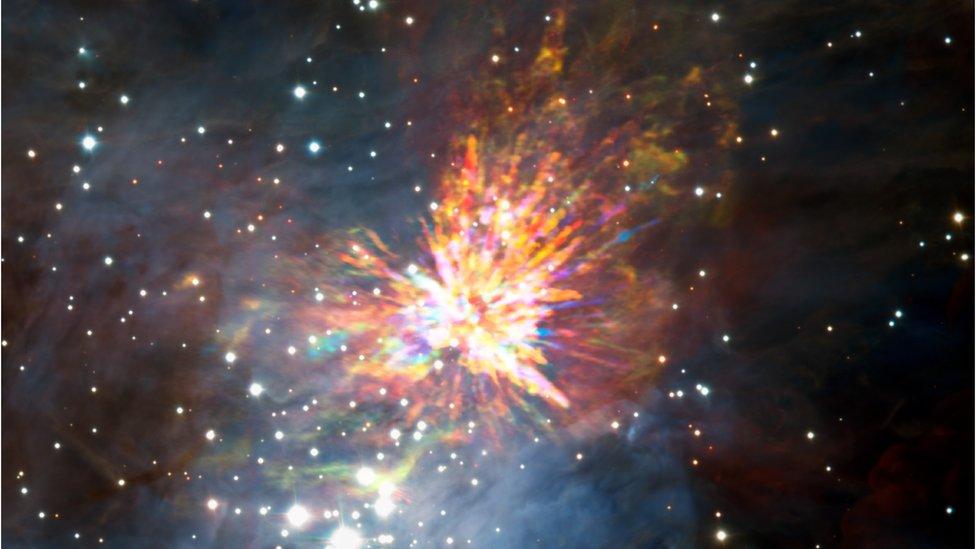Violent end as young stars dramatically collide
- Published

These dramatic images show the remains of a 500-year-old explosion from the birth of a group of massive stars
Scientists have captured a dramatic and violent image of the collision between two young stars that tore apart their stellar nursery.
Located in the constellation of Orion, the explosive event happened some 500 years ago sending giant streamers of dust and gas across interstellar space.
Researchers say the clash produced as much energy as our Sun would over 10 million years.
Details of the event have been .
The blue colour in the Alma data represents gas approaching at the highest speeds; the red colour is from gas moving more slowly.
Huge explosions in space are mostly associated with supernovas, which can take place in the dying moments of giant, ancient stars.
This new image though shows an explosion taking place at the other end of the stellar lifecycle.
Stars are born when a massive cloud of gas starts to collapse under its own gravity. At a distance of 1,500 light years from Earth, a number of very young stars began to form in a region called the Orion Molecular Cloud 1, (OMC-1).
Gravity pulled these proto-stars closer at increasing speed until about 500 years ago, two of them either grazed or collided head-on, triggering a powerful explosion that hurled gas and dust debris out into space at more than 150km per second.
Back in 2009, researchers first saw hints of the scale of the explosion. Now using the (Alma), based in northern Chile, astronomers have been able to see the violent event in high resolution.
Antennas of the Atacama Large Millimeter/submillimeter Array (ALMA), on the Chajnantor Plateau in the Chilean Andes seen at night
"What we see in this once calm stellar nursery is a cosmic version of a 4 July fireworks display, with giant streamers rocketing off in all directions," said lead author Prof John Bally from the University of Colorado.
The team has discovered new details about the structure of the streamers that extend past the explosion for almost a light year. The team members are learning about the distribution and high-velocity motion of the carbon monoxide gas inside the huge gas trails. It may also help their understanding of the star birth process.
"Though fleeting, proto-stellar explosions may be relatively common, by destroying their parent cloud, as we see in OMC-1, such explosions may also help to regulate the pace of star formation in these giant molecular clouds," said Prof Bally.
Scientists expect that explosions such as this one are most likely short-lived, with the remnants of the debris seen by Alma lasting only for centuries.
"People most often associate stellar explosions with ancient stars, like a nova eruption on the surface of a decaying star or the even more spectacular supernova death of an extremely massive star," Prof Bally said.
"Alma has given us new insights into explosions on the other end of the stellar life-cycle, star birth."
Follow Matt on and on .